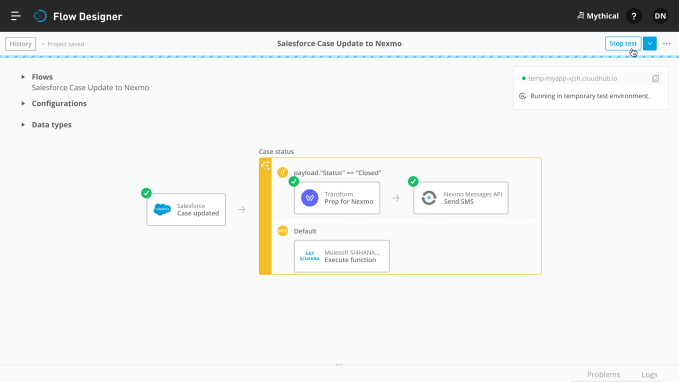A year and a half after getting acquired by Salesforce for $6.5 billion, MuleSoft is beginning to resemble a Salesforce company — using its language and its methodologies to describe new products and services. This week at Dreamforce, as the company’s mega customer conference begins in San Francisco, MuleSoft announced a slew of new services as it integrates more deeply into the Salesforce family of products.
MuleSoft creates APIs to connect different systems together. This could be quite useful for Salesforce as a bridge between older software that may be on-prem or in the cloud. It allows Salesforce and its customers to access data wherever it lives, even from different parts of the Salesforce ecosystem itself.
MuleSoft made a number of announcements designed to simplify that process and put it in the hands of more customers. For starters, it’s announcing Accelerators, which are pre-defined integrations that let companies connect more easily to other systems. Not surprisingly, two of the first ones connect data from external products and services to Salesforce Service Cloud and Salesforce Commerce Cloud.
“What we’ve done is we’ve pre-built integrations to common back-end systems like ServiceNow and JIRA in Service Cloud, and we prebuilt those integrations, and then automatically connected that data and services through a Salesforce Lightning component directly in the Service console,” Lindsey Irvine, chief marketing officer at MuleSoft, explained.
What this does is allow the agent to get a more complete view of the customer by getting not just the data that’s stored in Salesforce, but in other systems as well.
The company also wants to put these kinds of integration skills in the hands of more Salesforce customers, so they have designed a set of courses in Trailhead, the company’s training platform, with the goal of helping 100,000 Salesforce admins, developers, integration architects and line of business users develop expertise around creating and managing these kinds of integrations.
The company is also putting resources into creating the API Community Manager, a place where people involved in building and managing these integrations can get help from a community of users, all built on Salesforce products and services, says Mark Dao, chief product officer at MuleSoft.
“We’re leveraging Community Cloud, Service Cloud and Marketing Cloud to create a true developer experience platform. And what’s interesting is that it’s targeting both the business users — in other words, business development teams and marketing teams — as well as external developers,” he said. He added that the fact this is working with business users as well as the integration experts is something new, and the goal is to drive increased usage of APIs using MuleSoft inside Salesforce customer organizations.
Finally, the company announced Flow Designer, a new tool fueled by Einstein AI, which helps automate the creation of workflows and integrations between systems in a more automated fashion without requiring coding skills.

MuleSoft Flow Designer requires no coding (Screenshot: MuleSoft)
Dao says this is about putting MuleSoft in reach of more users. “It’s about enabling use cases for less technical users in the context of the MuleSoft Anypoint Platform. This really requires a new way of thinking around creating integrations, and we’ve been making Flow Designer simpler and simpler, and removing that technical layer from those users,” he said.
API Community Manager is available now. Accelerators will be available by the end of the year and Flow Designer updates will be available Q2 2020, according to the company.
These and other features are all designed to take some of the complexity out of using MuleSoft to help connect various systems across the organization, including both Salesforce and external programs, to make use of data wherever it lives. MuleSoft does requires a fair bit of technical skill, so if the company is able to simplify integration tasks, it could help put it in the hands of more users.